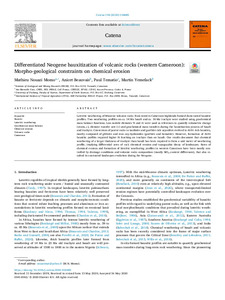| dc.contributor.author | Momo, M.N. |
| dc.contributor.author | Beauvais, A. |
| dc.contributor.author | Tematio, P. |
| dc.contributor.author | Yemefack, M. |
| dc.date.accessioned | 2022-08-16T10:04:24Z |
| dc.date.available | 2022-08-16T10:04:24Z |
| dc.date.issued | 2020-11 |
| dc.identifier.citation | Momo, M.N., Beauvais, A., Tematio, P. & Yemefack, M. (2020). Differentiated Neogene bauxitization of volcanic rocks (western Cameroon): Morpho-geological constraints on chemical erosion. CATENA, 194: 104685, 1-13. |
| dc.identifier.issn | 0341-8162 |
| dc.identifier.uri | https://hdl.handle.net/20.500.12478/7648 |
| dc.description.abstract | Lateritic weathering of Miocene volcanic rocks from western Cameroon highlands formed duricrusted bauxitic profiles. Two weathering profiles on ca. 14 Ma basalt and ca. 16 Ma trachyte were studied using geochemical mass balance functions. Less mobile elements Ti and Zr were used as references to quantify volumetric change (strain, ε), element transfer rate (τ) and geochemical mass transfers during the bauxitization process of basalt and trachyte. Conversion of parent rocks to kaolinite and goethite rich saprolites evolved to Al-Fe rich bauxites, mostly composed of gibbsite and iron oxy-hydroxides (goethite and hematite). However, formation of Al-Fe bauxitic profiles required higher Si leaching on trachyte than on basalt. Our results document that chemical weathering of a larger thickness of trachyte than basalt has been required to form a unit meter of weathering profile, implying differential rates of rock chemical erosion and topographic decay of landscapes. Rates of chemical erosion and formation of lateritic weathering profiles in western Cameroon have been mostly controlled by drainage conditions and volcanic rocks composition (mostly SiO2 content differences), that also resulted in contrasted landscapes evolution during the Neogene. |
| dc.format.extent | 1-13 |
| dc.language.iso | en |
| dc.subject | Weathering |
| dc.subject | Volcanic Eroptions |
| dc.subject | Erosion |
| dc.subject | Cameroon |
| dc.title | Differentiated Neogene bauxitization of volcanic rocks (western Cameroon): morpho-geological constraints on chemical erosion |
| dc.type | Journal Article |
| cg.contributor.affiliation | Institute of Geological and Mining Research, Cameroon |
| cg.contributor.affiliation | Aix-Marseille University |
| cg.contributor.affiliation | University of Dschang |
| cg.contributor.affiliation | International Institute of Tropical Agriculture |
| cg.coverage.region | Africa |
| cg.coverage.region | Central Africa |
| cg.coverage.country | Cameroon |
| cg.coverage.hub | Central Africa Hub |
| cg.identifier.bibtexciteid | MOMO:2020 |
| cg.isijournal | ISI Journal |
| cg.authorship.types | CGIAR and developing country institute |
| cg.iitasubject | Climate Change |
| cg.iitasubject | Meteorology and Climatology |
| cg.journal | Catena |
| cg.notes | Published online: 30 May 2020 |
| cg.accessibilitystatus | Limited Access |
| cg.reviewstatus | Peer Review |
| cg.usagerightslicense | Copyrighted; all rights reserved |
| cg.targetaudience | Scientists |
| cg.identifier.doi | https://dx.doi.org/10.1016/j.catena.2020.104685 |
| cg.iitaauthor.identifier | Martin YEMEFACK: 0000-0002-6709-8503 |
| cg.futureupdate.required | No |
| cg.identifier.volume | 194 |

